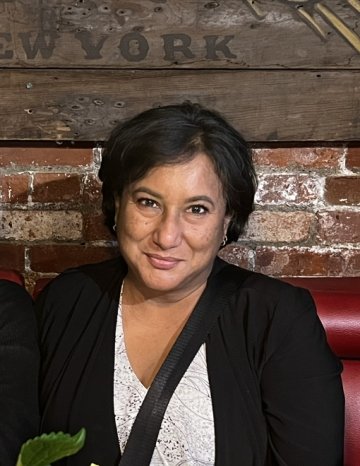“For me, archaeology and anthropology are intellectual quests. They gave me the opportunity to be whatever I wanted to be.”
Before finding archaeology, Dr. Shinu Anna Abraham wanted to be a psychologist, a detective, and a translator. In her early career, she worked as a technical writer and an editor, but this was all before realizing that she felt more comfortable in academia –a place where she could grow intellectually. In anthropology, she found a field that allowed her to explore her own identity, and her place in the world.
“Anthropology gave me an opportunity to learn more about myself, and how I fit into this very complex world… Understanding myself, understanding the other, wondering where these ideas came from, what they could do for our worldviews…”
Her interest in history, the past, science fiction and detective stories all merged into the melting pot of archaeology. In this field, Dr. Abraham is able to “put bits and pieces together, not to create fantasy, but to create an understanding of what it means to be human.” When she first started out in archaeology, she was always interested in understanding India as part of Indian Ocean relations. Her undergraduate university education in India as well as her heritage led her to dedicate years of her career to this very topic. She shared: “It really fascinated me that India was at this nexus, in this very large complex set of relationships”, especially with the Roman Empire. Although Dr. Abraham’s doctoral dissertation focused on early burials and pottery, she quickly turned to the study of glass and stone beads.
She started researching beads following a friend's suggestion, recognizing the need for this type of research in the field of archaeology. While studying beads in Pattanam she realized that “it was a way to answer both small scale questions as well as large regional interactive questions.” Her doctoral training at the University of Pennsylvania allowed her to explore how an object many of us don’t pay much attention to, such as a bead, can tell the story of a region’s history and its connections to other parts of the world over hundreds of years. Dr. Abraham’s research has been published in the Annual Review of Anthropology and she has received grants from distinguished organizations such as National Geographic and the National Science foundation. Her extensive research provides us with a deeper understanding of South Indian history and its role in Indian Ocean trade. The journey of these beads, from their beginning in humble small villages in South India to ancient elite burials in Europe and Japan, reflects patterns of trade that reveal much of how ancient civilizations functioned.
“In a sense as I talk about it, this little object is like me, like an immigrant found far away from its place of origin. So what I’m trying to do is understand its story. [...] I study these beads in order to understand the people behind them.”
Dr. Abraham discovered she enjoyed being an educator during a teaching assistantship at Binghamton University. While in the beginning she was nervous, this opportunity helped her deepen her understanding of her own field. Nowadays, she likes teaching in a liberal arts environment, where she can get students interested and critically engaged with the ideas of archaeology and anthropology. She inspires students to think critically, to carry out evidence-based analysis, and develop a curiosity about the world while placing its issues in context. It took her some time to tailor her love of archaeology into a skill for teaching it, but St. Lawrence University provided a chance for that to happen. In the Fall of 2024, she received the Calvin Keene award, an award given annually to a faculty member who shows outstanding teaching and moral concern as well as high standards of scholarship. In her own words, receiving the award “was a recognition that I understood, given my own complex background, how to make my own presence a positive impact, not just for students and colleagues, but also for myself.”
At St. Lawrence University, Dr. Abraham teaches Introduction to Archaeology as well as courses on ancient civilization, material life and society, archaeological methods and anthropological theory. She shares: “I feel really lucky to be in a great department, where we all work well together, and I think our students appreciate that.”

Recent publications (back to 2020):
“Recent Developments in the Archaeology of Long-Distance Connections Across the Ancient Indian Ocean.” Annual Review of Anthropology, Volume 52: 115-35. (2023)
L Dussubieux, T Fenn, SA Abraham, AK Kanungo, “Tracking Glass Production in India: Elemental and Isotopic Analysis of Raw Materials.” Archaeological and Anthropological Sciences 14(12): 226. (2022)
SA Abraham, P Gullapalli, KP Rao, “Investigating Early Pyrotechnologies: Contextualizing Glass Working in Southern Andhra Pradesh.” In Culture and Cognition: Reconstructing the Past: Essays in History, Culture, and Archaeology, KP Rao and MN Rajesh, eds. Delhi: Sharada Publishing House, pp. 85-96. (2022)
“A Review of Selected Glass Bead Types from the 2007-209 Seasons of Excavation at Pattanam, India.” In Ancient Glass of South Asia: Archaeology, Ethnography and Global Connections. AK Kanungo and L. Dussubieux, eds. Singapore: Springer, pp. 345-359. (2021)
SA Abraham, P Gullapalli, KP Rao, “The Production Landscapes of Southern Andhra Pradesh: The Swarnamukhi River Valley Survey.” South Asian Archaeology and Art 2014: Papers Presented at the 22nd International Conference of the European Association of South Asian Art and Archaeology. E Myrdal, ed. New Delhi: Dev Publishers, pp. 153-168. (2020)
Sources:

